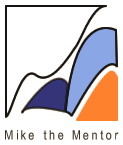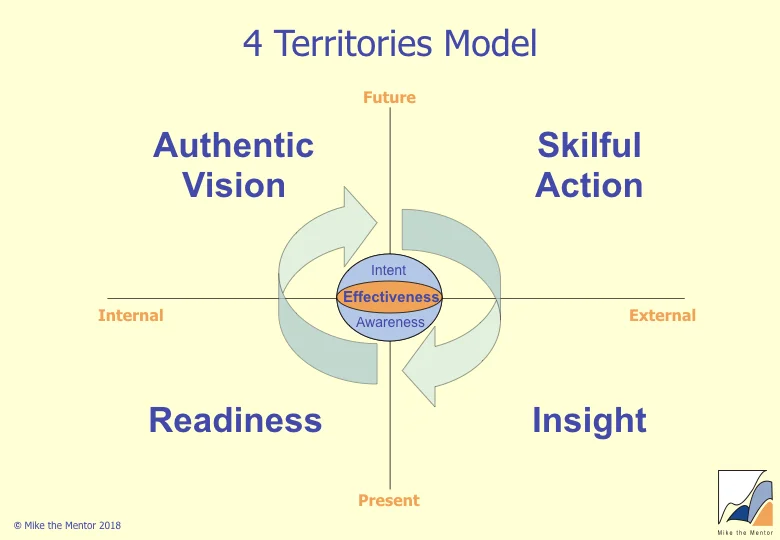The 6 levels of Coaching
/Over Here and Over There Resources
A coach has two basic sets of resources to help them coach: their own resources and those of the person they are coaching. From the coach’s perspective these are "Over Here" or "Over There" resources:
Over Here interventions are those in which the coach uses what is going on for them (the coach) - (their own thoughts, feelings, intuition, experience, expertise, etc) to help the coachee move forward and achieve their goals.
Over There interventions are those in which the coach uses what is going on for the coachee (the coachee’s thoughts, feelings, intuition, experience, expertise, etc) to help the coachee move forward.
People new to coaching and the helping professions are usually most comfortable trying to help others by suggesting what they might do differently and sharing their knowledge and expertise (ie, using Over Here resources - also known as directive coaching). Because breaking this preference for telling is difficult, coach training programmes have a relentless focus on helping the novice coach shift their attention away from telling the coachee what to do, to helping the coach learn how to surface and explore the coachee's own resources and resourcefulness..
The 6 Levels of Coaching
This shift by the coach from focusing on their own thoughts, knowledge and expertise (a focus within the coach's mind or Over Here), to focusing on what is going on for the coachee, what they know about the situation and what they are interested in pursuing (a focus on the overt interests of the coachee Over There) is shown by the red arrow on the diagram.
The moment of breakthrough occurs when the coach realises that it is the coachee, not themselves, who has to do the hard work of discovering how to change! Indeed, one of the most reliable signs that a coach has "lost it" in a session is the feeling of trying hard!
The danger of this emphasis on following the overt interest of the coachee is that the coach comes to believe that it is the only way to coach. But, as the diagram shows, there are a range of different types of intervention that the effective coach can make.
The 6 Levels of Coaching
There are 6 levels of coaching, each of a greater complexity than the previous one:
Befriending
This term comes from the Samaritans and is used to describe an approach to listening which provides emotional support to people in crisis. We put our attention 'over there' on the coachee and focus on hearing what's going on for them whilst putting on one side the comments, ideas, insights, and questions that are arising in our own minds. As anyone who as experienced being truly listened to and being seen as we are, this can be a powerfully transformative experience.
Telling
This is the default, untrained approach that we tend to take where we believe we can help where we come up with solutions or suggestions for the coachee. When used judiciously and in a timely fashion, the sharing of experience and knowledge can be a powerful aid. But just because we have some useful information, that doesn't mean we should share it. The test with this - as with all the other interventions here - is whether making the intervention will help or hinder the coachee. If you're not sure, wait.
The most fundamental limitation of Telling or Being an Expert is that it means that the coach can never coach someone who knows more than they do - to do this the coach has to learn to help the coachee use their own resources, for example by following the coachee's interest. One way we did this when I was with
Following Interest (Overt)
This is the core of Non-Directive coaching. We place our attention "over there' on the coachee's reality - their thoughts, feelings, ideas, agenda, etc - and help them identify what they want to get from the coaching, what relevant knowledge and expertise they already have, and how they can use these to achieve the outcome they desire. The coach is non-directive about content, but directive in structuring the coaching conversation so that it delivers what the coachee needs. When I was training coaches at the School of Coaching we took participants onto the tennis court for a day. There they had the powerful, and often transformative, experience of successfully coaching a fellow participant to improve their tennis despite not only knowing nothing about tennis coaching, but in some cases despite having never played tennis before!
Only when an aspiring coach has mastered the ability to use the coachee's experience to inform the coaching can they really start to use their own "over here" experience effectively.
Using All of Myself
Here we bring our attention back Over Here but now being aware of the whole of ourselves (rather than just our minds) to inform our interventions - what we're feeling, imagining, needing, desiring and intuiting. Now we have access to both rational and non-rational sources of information. This requires the courage to trust what we are feeling, to be vulnerable, and to bring more of who we are to the coaching relationship. But if we're able to do this, we bring a rich range of information to the coaching.
By using our imagination we can create hypotheses about what might be going on for the coachee, and then test these out; we can notice our own emotions as we sit with the coachee, and wonder whether they may be telling us something useful about what the coachee might be excluding; we can connect to our gut instinct and what it is telling us may be emerging into the coachee's life. We can hypothesise what might be going on for the coachee that they are unaware of and find ways to test the hypotheses. And we can give the coachee live feedback about the impact they have on us.
Following Interest (Covert/Tacit)
Who's agenda should we follow in a coaching session? The immediate answer is of course that it is the coachee's agenda. But it’s not as simple as this. The coachee will have an overt, explicit agenda and goals for the coaching that they can articulate to us. But there is also a larger context within which the coaching happens: the journey the coachee is making through their lives to the fullness of who they are. The nature of this journey is often elusive and unfolds only gradually. A key role we can play is to help the coachee notice these subtle signs of unfolding and emergence, and encourage them into being, so that they can cooperate with and encourage what is happening rather than work against it. In terms of Psychosynthesis these signs can be thought of as emerging from our unconscious – either the lower unconscious when patterns that no longer serve are ready to be resolved and transcended or the higher unconscious when some aspect of their potential and future is ready to be embraced. So we focus on two things: the overt topic that the coachee is directly presenting to us and the journey through life that the coachee is travelling - their wider life purpose. This bifocal vision enables us to serve both who the client is and who they are becoming.
Following this implicit interest requires a higher level of skill and sensitivity since it is more easy to get this wrong than when following the coachee's explicitly stated interest.
Coming from Source
David Bohm, the physicist and explorer of consciousness, said "the reality which is most immediate to us cannot be stated". This reality, though immanent and ever present, and indeed all that is, is, for most of us, elusive. This reality, eloquently described by Joe Jaworski in his book Source: The Inner Path of Knowledge Creation, is similar to Csikszentmihalyi's Flow state, to the non-dual state, and to Bohm's Implicate Order. When we let go to Source we can access a wider trans-personal intelligence. We notice its presence when we feel awe at what has happened in a coaching session - we know that we have witnessed something extraordinary - and we can only wonder at the magic that has happened.
Each subsequent level transcends and includes all the earlier levels. The effective coach aspires to operate in all these modes simultaneously, bringing as much of themselves and of their coachee into the present moment as possible.
As is usually the case with these multi-level models there is no one best intervention - that depends on what the moment calls for. But the more flexibility we can have in using the different interventions the more effective we can be as coaches.
This framework is inspired in part by models of adult development where the terms "Conventional" and "Post-Conventional" used on the diagram are explained.


